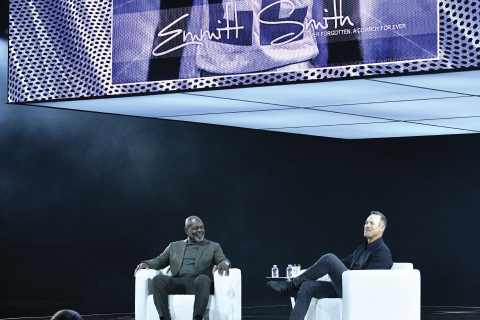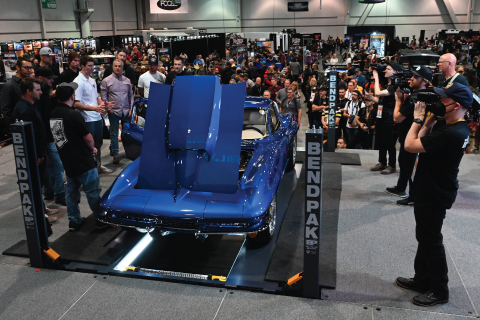EVENTS
Compiled by SEMA News Editors
2020 Battle of the Builders
12 Finalists, One Overall Winner at SEMA’s Annual Celebration of the Builder’s Art
Since its inception in 2014, the SEMA Show’s annual Battle of the Builders (BOTB) has become one of the most anticipated events of SEMA Show week. While the cancellation of the 2020 Show in Las Vegas seemed to put the event on hold for a year, there was still plenty of industry interest in holding a BOTB-type event, even if done remotely.
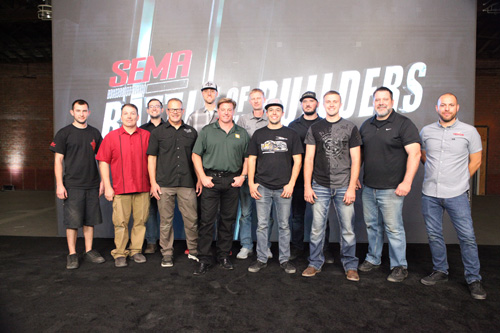
Enter the SEMA360 Builder Showcase, an online exhibit created last November to provide a forum for builders and customizers to display their latest works during the week of SEMA’s first-ever virtual trade show. Despite being set up on short notice, the showcase attracted more than 300 entries from around the world. From those, SEMA staff and a panel of industry experts narrowed the field to a list of Top 40 vehicles that would be invited to participate in an online version of BOTB.
After careful review, those 40 were winnowed down to 12 finalists in four categories (Hot Rod, Truck/Off-Road, Sport Compact and Young Guns). The finalists’ vehicles were transported to a location in Los Angeles during SEMA360 week for “peer review” (the builders also act as judges at BOTB, evaluating each others’ work), with an overall winner being announced on the last day of the Show.
The competition was featured in a nationwide BOTB TV special that premiered on A+E Networks’ FYI and HISTORY’s DRIVE Block on February 7 at 9:00 a.m. EST. For the latest broadcast information, visit www.sema.org/botb.
What follows is a review of the one-of-a-kind creations that made the journey to Southern California for the event.
CAPTION: Competing at the 2020 Battle of the Builders were (from left) Cody Medeisis, Todd Budde, Kyle Kuhnhausen, Randy Borcherding, Austin Phipps, Chip Foose, Andy Leach, Brad DeBerti, Josh Croll, Eli DeWitt, Brady Ranweiler and Mark Giambalvo.
For more information about the 2020 Battle of the Builders competition, visit www.sema.org/botb.
_______________________ _______________________
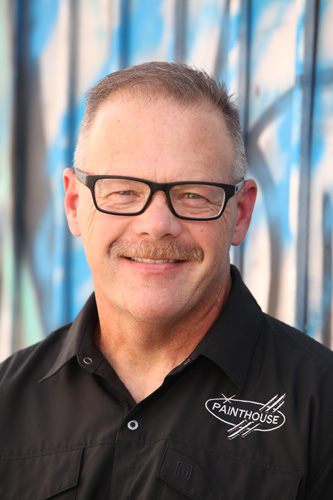
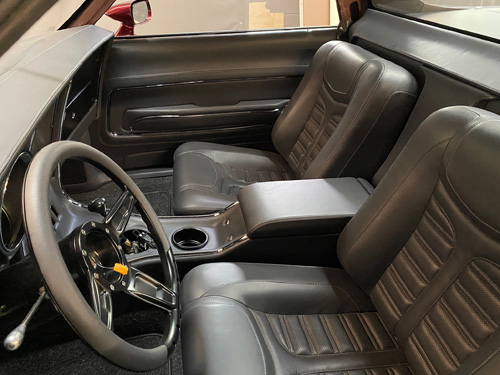 Builder: Randy Borcherding
Builder: Randy Borcherding
Paint House, Cypress, Texas
Vehicle: ’71 Ford Ranchero
Category: Truck/Off-Road
“Our building style is the Pro Touring look, with modern electronics, modern engines, modern brakes and an aggressive stance, yet the classic musclecar/hot-rod shape is still left intact,” Randy Borcherding explained.
The Truck category winner at 2019 BOTB, Borcherding came to SEMA360 with this eye-catching Ranchero. It’s not a common vehicle, he admitted, but it stands out in any crowd. The first thing you notice is the flawless application of custom-mixed Dark Maroondy Pearl two-stage PPG base coat/clear coat that adorns the bodywork. It’s complemented by a matte charcoal-gray strip across the hood that incorporates a factory scoop.
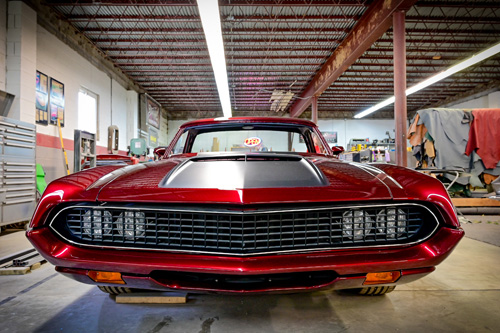 The Torino GT-style front end includes a custom billet grille that hides the headlights, and the front bumper has been meticulously shortened, narrowed and tucked. Rear bodywork includes custom bed moldings that were formed out of high-end resin, with chromed inserts all hand-fabricated from chrome-plated brass. Also in the rear are a narrowed and tucked rear bumper, a fold-down rear tailgate, a power tonneau cover, and custom acrylic taillight lenses over LED light strips.
The Torino GT-style front end includes a custom billet grille that hides the headlights, and the front bumper has been meticulously shortened, narrowed and tucked. Rear bodywork includes custom bed moldings that were formed out of high-end resin, with chromed inserts all hand-fabricated from chrome-plated brass. Also in the rear are a narrowed and tucked rear bumper, a fold-down rear tailgate, a power tonneau cover, and custom acrylic taillight lenses over LED light strips.
“We wanted to make it cleaner and a little tighter without ruining the factory look,” Borcherding said.
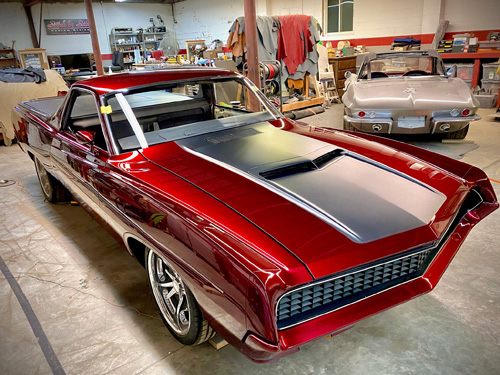 Beneath the hood is a throwback engine—a balanced and blueprinted 351 Cleveland V8 that was bored to displace 408 ci. While it’s the same engine that would’ve come in the truck originally, Borcherding noted, it’s been upgraded with fuel injection and also sports a custom dual air intake and a performance cam.
Beneath the hood is a throwback engine—a balanced and blueprinted 351 Cleveland V8 that was bored to displace 408 ci. While it’s the same engine that would’ve come in the truck originally, Borcherding noted, it’s been upgraded with fuel injection and also sports a custom dual air intake and a performance cam.
The filters have been mounted under the fenders to reduce clutter in the engine bay and optimize air flow. The stock Ranchero suspension was replaced with a Mustang II coil-over front setup and four-link in the rear. The Ranchero rolls on Schott Accelerator concave wheels and Michelin tires, and Wilwood disc brakes reside at all four corners.
Inside, an all-custom Stitch By Stitch gray leather interior features custom seats and a fitted headliner, and it’s accented with handmade brass moldings that combine a classic look with a luxurious contemporary feel. Also inside the cab are a narrowed ’71 Mustang dash, a full set of Dakota Digital gauges, a Lokar shifter, a hidden Alpine audio system, and GT 40-style switch gear.
_______________________ _______________________

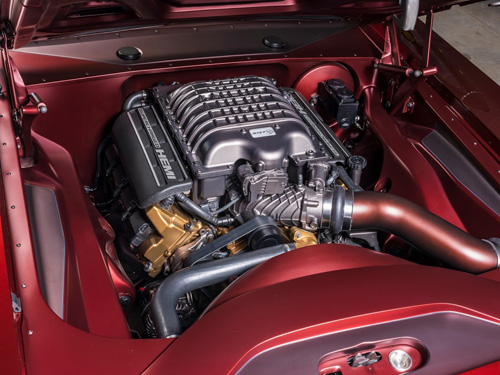 Builder: Andy Leach
Builder: Andy Leach
Cal Automotive Creations, Bennington, Nebraska
Vehicle: ’71 Plymouth Barracuda
Category: Hot Rod
“I never went to school for any of this—just trial and error, with lots of error,” Andy Leach admitted of his building background. But only 10 years after forming his own customization company, he’s now building some of the baddest cars on the planet, of which this frame-up ’71 Barracuda is a shining example.
Powering the third-generation pony car is a 707hp Hellcat crate engine tied to a Bowler T56 six-speed transmission. The Hellcat is a huge engine, so the engine bay abounds in custom bodywork that was undertaken to accommodate it.
The hood was extensively modified, and all underhood bracing was made from scratch to clear the supercharger. The front wheel arches, bumper and valance were meticulously resculpted to tighten gaps and provide smoother styling lines. The front coil-over suspension was built from scratch to compensate for changes in geometry and front/rear weight distribution, and a custom coil-over/four-link setup locates a Dana rearend in back. All of those changes were made with one thing in mind, Leach said: “Functionality. That’s what we do.”
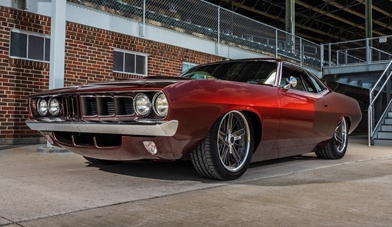
The Plymouth rolls on 18x8 and 20x10 one-off Evod wheels that provide a timeless look, and they’re complemented by a set of Baer brakes. The Plymouth’s rear wheel openings were reshaped to clear extra-wide 295/20R tires, and the rear end, as with the front, was largely cobbled from scratch, with an all-custom rear bumper and valance and machined exhaust tips. The stock grille was completely modified; the taillights were reworked for improved fitment; and the rockers were dropped to mimic the factory look.
“We really wanted to keep the interior ’71 ’Cuda,” Leach said. The noticeable addition of a color-coordinated rollcage blends nicely with the machine-trimmed dash, door panels and custom Glide-frame seats, and all of the window trim was reshaped. The door tops and handles have all been machined, and the custom center console evokes the look of a vintage ’70s musclecar while being a one-off design.
_______________________ _______________________

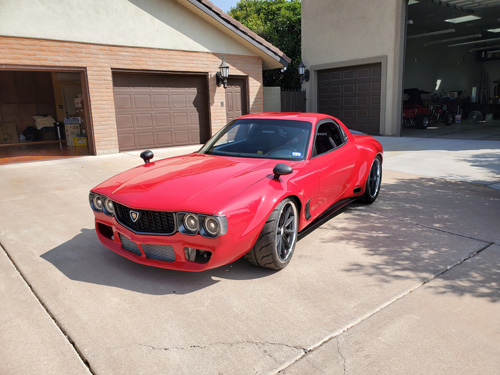 Builder: Todd Budde
Builder: Todd Budde
FabFitters, La Vernia, Texas
Vehicle: ’93 Mazda RX-7 FDS3
Category: Sport Compact
The son of a Super Modified racer, Todd Budde was exposed to exotic, high-performance rides from childhood.
“My father was always interested in unique builds,” he said, and that interest in time led the son to this unique all-wheel-drive RX-7 that, in Budde’s estimation, took some 7,000 man-hours to turn into the creation you see here. (“It started its life as a totaled car, and I’m a one-man shop,” he explained.)
Starting under the hood, the original powerplant was swapped out in favor of a high-performance billet 26B four-rotor engine manufactured by Billet Pro in Australia. Twin Garrett G42-1200 turbos provide aspiration and boost, and the 6-in. exhaust, engine piping and intercooler were all hand built. The entire exhaust system was removed and sent to PTP Turbo Blankets for 3-D scanning. When completed, the exhaust came back with a custom set of blankets installed to keep heat output to a minimum.

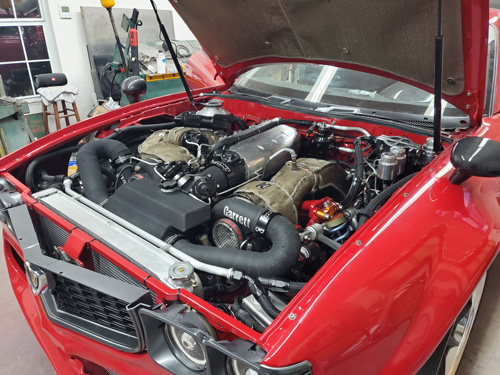 Backing the engine is a Corvette C5-style torque-tube transmission that engages a Lamborghini Gallardo transaxle, which was relocated to the back of the car. Custom front and rear subframes accommodate Corvette C7 control arms, uprights and a DSC adaptive-shock system. Electronic power steering comes courtesy of a Toyota Yaris, and the 19-in. Vossen wheels are stopped by a set of Wilwood disc brakes.
Backing the engine is a Corvette C5-style torque-tube transmission that engages a Lamborghini Gallardo transaxle, which was relocated to the back of the car. Custom front and rear subframes accommodate Corvette C7 control arms, uprights and a DSC adaptive-shock system. Electronic power steering comes courtesy of a Toyota Yaris, and the 19-in. Vossen wheels are stopped by a set of Wilwood disc brakes.
Front and rear hand-formed bodywork incorporates multiple OE design cues while aspiring to resemble an all-steel wide-body kit. Immediately noticeable is the front end from a ’70s Series 1 RX-3, and the grille was updated and modernized with LED projector headlights. The fenders and side panels use elements of RX-7, RX-3, BMW M3 and Volkswagen Beetle sheetmetal. In the rear, Evo-R taillights feature the same sequential turn-signal pattern as a Lamborghini.
Carbon-fiber trim abounds inside and out, adorning the mirrors, side skirts and interior panels to give the Mazda a JDM theme. A gated shifter sourced from an Audi R8 delivers gear changes, and a digital dash from AEM houses a complement of gauges.
_______________________ _______________________
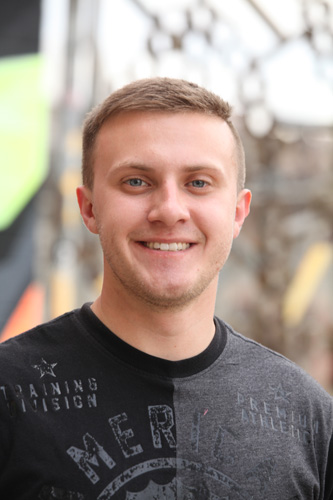
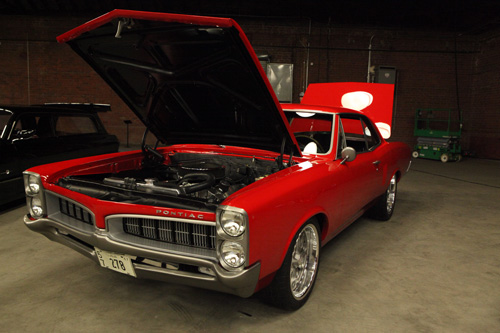 Builder: Eli DeWitt
Builder: Eli DeWitt
Solon, Iowa
Vehicle: ’67 Pontiac Le Mans
Category: Young Guns
According to Eli DeWitt, this build originated in 2010 when he went searching for a lost cat in his neighborhood. During the search, he came upon a ’67 Le Mans that was parked in a neighbor’s garage, apparently unused for some 10 years. The car appeared to be in decent shape overall but needed a lot of “rust work.” Upon purchasing the ride, DeWitt embarked upon a 1,000-hour frame-off restoration.
After the bodywork was cleaned up with the bumpers shaved, the gaps tightened, and a coat of Axalta Mosaic Victory Red applied, more than 100 hours were spent on wet sanding and buffing to achieve the desired finish. The remaining chrome and stainless-steel pieces were stripped and refinished in PDC Chrysler pewter grey pearl to match the finish on the U.S. Mag Rambler wheels.
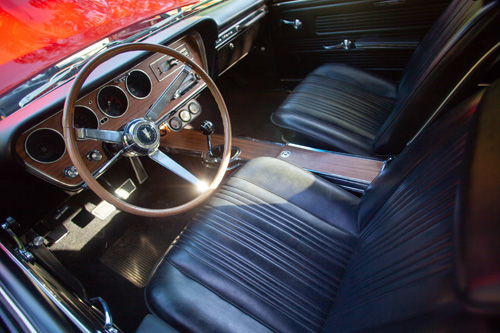
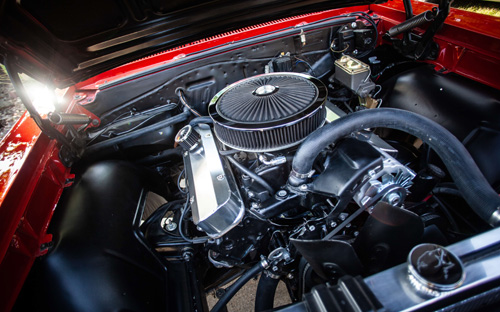 Overall, the bodywork was in good shape for a garage find. Only sections of the front flooring and lower rear quarter-panels were in need of replacing, and the GTO-style hood is the only aftermarket body piece.
Overall, the bodywork was in good shape for a garage find. Only sections of the front flooring and lower rear quarter-panels were in need of replacing, and the GTO-style hood is the only aftermarket body piece.
Under the hood, a 400 V8 sourced from a ’74 Bonneville was bored to displace 408 ci. The engine received a total makeover, with only the block and crank remaining of the original pieces. Further power upgrades came in the form of a Quick Fuel Technology 650-cfm Black Diamond carburetor, an upgraded cam and a custom-bent exhaust. A Frostbite Radiator keeps everything running cool, and a local shop custom-bent the one-off exhaust system, which also includes Quick Time Performance electric exhaust cutouts.
The engine is backed by a four-speed manual transmission, and the car rolls on a suspension that’s lowered 2 in. in front with Speedway drop swindles and 11/4 in. in back with drop springs. A QA1 dual adjustable coil-over front suspension with SSBC disc brakes locates the frontend, and Nitto NT555 ultra-high-performance tires provide on-road grip.
Inside the Pontiac, everything is as it appeared on the showroom floor in 1967, save the headliner and carpeting.
“It was in such good shape, I wanted to keep it that way,” DeWitt explained.
_______________________ _______________________
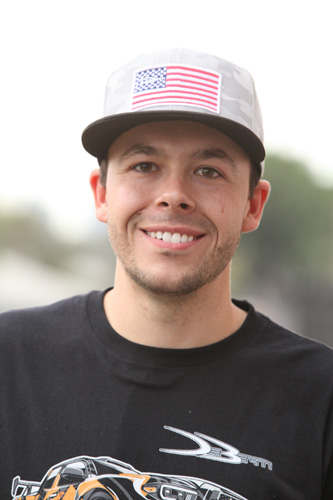
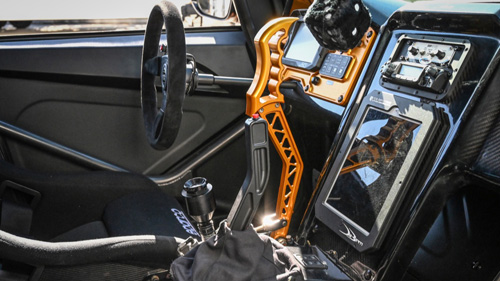 Builder: Brad DeBerti
Builder: Brad DeBerti
DeBerti Products, Mooresville, North Carolina
Vehicle: ’20 Toyota Tacoma
Category: Truck/Off-Road
Built to combine the design of an Indy Car and the design of hot rod into one vehicle, this Tacoma was completely built from the ground up in only 90 days, Brad DeBerti said. At this point, the doors and roof are the sole remaining OE components.
Built for all kinds of racing, the truck rides on a custom tube chassis sourced from Tekk Consulting and features bodywork from Advanced Fiberglass Concepts, including the fenders, roof scoop, rear diffuser, front splitter and side skirts that were all machined out of high-density foam. The fuel cell and radiator were moved rearward in the truck to better enable 50/50 front-to-rear weight distribution, and TRD provided technical assistance to improve aerodynamics.
Under the hood is a race-winning TRD NASCAR Cup-series naturally aspirated truck engine displacing 420 ci and generating 900 hp. A set of handmade Gibson headers feeds into a TRD-designed tri-Y exhaust.
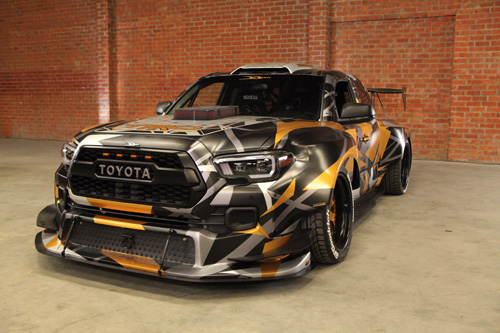
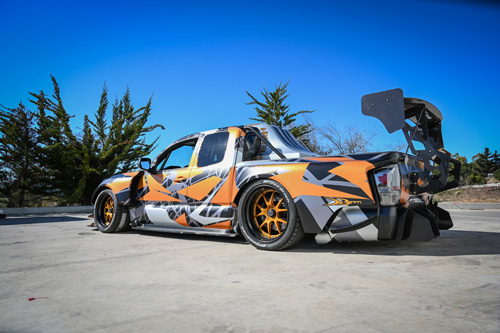 The engine is backed by a six-speed sequential transmission that sends power to the rear via a QA1 carbon-fiber driveshaft to a QA1-damped RTS Winters quick-change rearend that’s rated to stand up to 2,000 hp. The center-lock (single-lug) Forgeline wheels are enveloped by BFGoodrich tires and halted by Alcon brakes. The truck is additionally equipped with nitrogen-actuated air jacks that can lift the entire vehicle 5 in. Up front, a 74-degree custom steering angle enables extreme drifting maneuvers when working in tandem with the DeBerti-designed in-cab hand brake.
The engine is backed by a six-speed sequential transmission that sends power to the rear via a QA1 carbon-fiber driveshaft to a QA1-damped RTS Winters quick-change rearend that’s rated to stand up to 2,000 hp. The center-lock (single-lug) Forgeline wheels are enveloped by BFGoodrich tires and halted by Alcon brakes. The truck is additionally equipped with nitrogen-actuated air jacks that can lift the entire vehicle 5 in. Up front, a 74-degree custom steering angle enables extreme drifting maneuvers when working in tandem with the DeBerti-designed in-cab hand brake.
As with most vehicles built exclusively for racing, the Toyota’s interior is relatively simple and unadorned, though carbon fiber is used extensively for greater weight reduction. A custom-machined aluminum dash houses a host of AEM electronics and a Switch Pros power panel along with a Safecraft fire extinguisher. A trio of Sparco racing seats and harnesses (yes, the truck’s a three-seater) keep the driver and passengers secure in the cab.
_______________________ _______________________
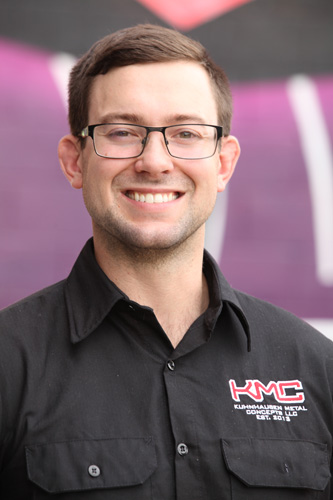
 Builder: Kyle Kuhnhausen
Builder: Kyle Kuhnhausen
Kuhnhausen Metal Concepts, Creswell, Oregon
Vehicle: ’64 Chevrolet Corvette
Category: Hot Rod
“It’s not too flashy, so you can appreciate the craftsmanship and the traditional needs on a hot rod,” Kyle Kuhnhausen said of his C2 Corvette. “But at the same time, it will draw you in and, hopefully, drop your jaw to the floor.”
“Ballistic Beige” certainly retains much of the original interior and exterior aesthetics (it still retains the OE side pipes), but pop the hood and this ’Vette is transformed into the modern age—specifically via an Art Morrison Builder Series chassis that cradles a GM Performance LT4 equipped with builder-machined ARP bolts and offering 650 hp and 650 lb.-ft.
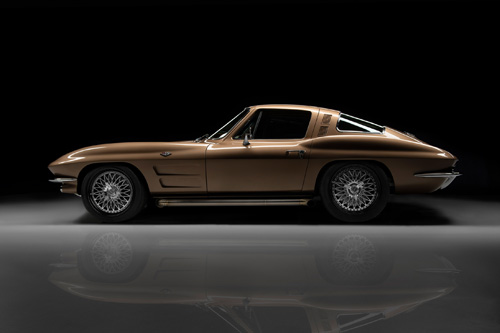 Keeping the engine cool is a C7-inspired, horizontally mounted C&R cooling package incorporating a custom supercharger heat exchanger and radiator that are topped with a custom shroud with a titanium exhaust pipe and dual 11-in. brushless SPAL fans. Many components were relocated to optimize front-/rear-weight distribution or to create a clutter-free engine bay. The oil cooler was relocated to the rear to free up space underhood, and the supercharger assembly also houses a power-steering reservoir.
Keeping the engine cool is a C7-inspired, horizontally mounted C&R cooling package incorporating a custom supercharger heat exchanger and radiator that are topped with a custom shroud with a titanium exhaust pipe and dual 11-in. brushless SPAL fans. Many components were relocated to optimize front-/rear-weight distribution or to create a clutter-free engine bay. The oil cooler was relocated to the rear to free up space underhood, and the supercharger assembly also houses a power-steering reservoir.
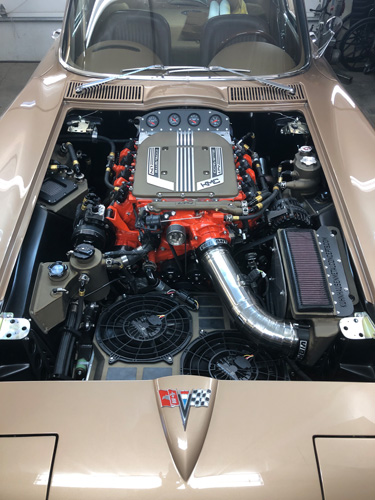 The engine is mated to a 4L75E transmission that’s cooled by a modified 10-row oil-to-water cooling unit that’s mounted behind the radiator. The gearbox transfers power to a Strange S60 IRS differential using a QA1 carbon-fiber driveshaft. JRI double-adjustable coil-overs augment the suspension, and a set of 14-in. Wilwood brakes halt the 295/19 front and 345/19 rear Michelin tires that ride on Forgeline LS3 three-piece rims.
The engine is mated to a 4L75E transmission that’s cooled by a modified 10-row oil-to-water cooling unit that’s mounted behind the radiator. The gearbox transfers power to a Strange S60 IRS differential using a QA1 carbon-fiber driveshaft. JRI double-adjustable coil-overs augment the suspension, and a set of 14-in. Wilwood brakes halt the 295/19 front and 345/19 rear Michelin tires that ride on Forgeline LS3 three-piece rims.
The inside retains much of its original look. The Sparco steering wheel uses the stock horn button, but Kuhnhausen said that the interior also contains lots of cool James Bond bits. A complement of Dakota Digital HDX gauges now monitor underhood functions; a Lokar shifter engages the 4L75; and a Sparco steering wheel gets a power assist courtesy of a Woodward Race Rack.
Outside, subtle touches abound. The front bumpers were sectioned 1 in. over stock and tucked in 11/2 in. on the sides, helping to enhance air flow to the radiator. Prismatic Powders provided powdercoating, and Axalta paint and Cerakote ceramic coating keep the exterior looking like new.
_______________________ _______________________

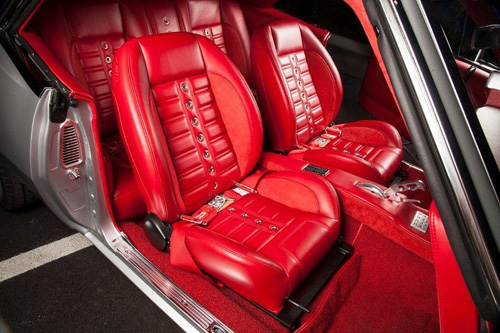 Builder: Austin Phipps
Builder: Austin Phipps
Phipps Built, Hermiston, Oregon
Vehicle: ’68 Chevrolet Camaro RS
Category: Young Guns
Most builders start to pursue their passion at a relatively early age. Then again, there are builders like Austin Phipps, who purchased this Camaro at age 13. It attracted his attention, he said, “due to the hideaway headlights of the Rally Sport, and I knew then that it was going to be the first car I was going to build.” Eight years later, it’s the sharp-looking tourer you see here.
The fun starts under the hood with a 400-plus-hp 383 Gen I small-block stuffed with all kinds of internals and bolt-ons from BluePrint Engines, including aluminum cylinder heads, a cast-steel crank, rods and pistons, and a roller camshaft. A Holley Sniper EFI system provides aspiration, and Hooker Super Comp headers and MagnaFlow Super 44 exhaust handle the spent gases.
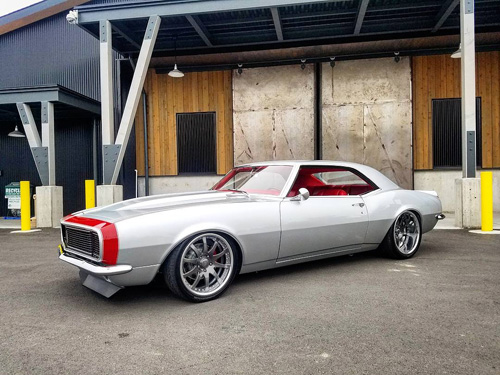
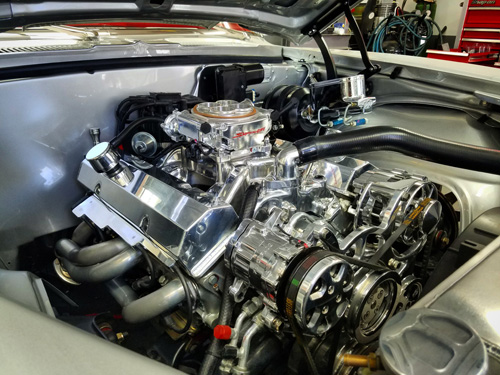 The engine is mated to a 700-R4 transmission that sends power to a narrowed Dutchman Motorsports 10-in. rearend equipped with an Eaton Detroit Locker. An AccuAir suspension kit is plumbed into the chassis, and the rear features an owner-built triangulated four-link. Rushforth Rated X smoked-titanium wheels and Nexen tires keep the Chevy rolling, and a set of CPP disc brakes brings it to a halt.
The engine is mated to a 700-R4 transmission that sends power to a narrowed Dutchman Motorsports 10-in. rearend equipped with an Eaton Detroit Locker. An AccuAir suspension kit is plumbed into the chassis, and the rear features an owner-built triangulated four-link. Rushforth Rated X smoked-titanium wheels and Nexen tires keep the Chevy rolling, and a set of CPP disc brakes brings it to a halt.
Inside, all upholstery was handled by Phipps and his father Robert, and TMI provided the Porsche-red vinyl interior kit that features low-back front seats as well as the door, kick and quarter-panels. Auto Meter carbon-fiber gauges monitor underhood functions, and Classic Industries OER parts combine old-school aesthetics with digital technology. A Nardi woodgrain steering wheel lends another classic touch, and a modified B&M shifter handles gear changes.
Outside, Ringbrothers door handles and Eddie Motorsport hood hinges and door vents add further styling cues, and the bodywork was covered in an application of PPG DBC formula Switchblade Silver paint with red accents—a timeless design, in Phipps’ words.
_______________________ _______________________
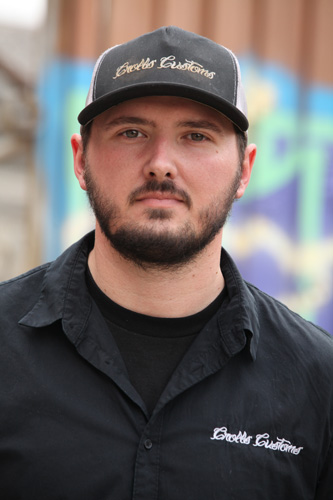
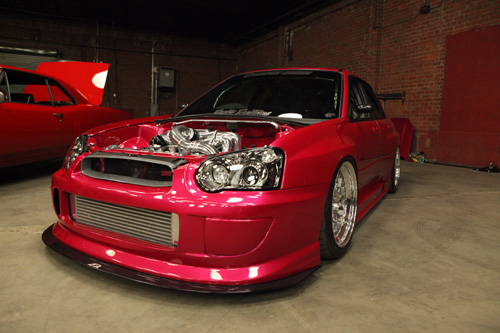 Builder: Josh Croll
Builder: Josh Croll
Croll’s Customs, Slatington, Pennsylvania
Vehicle: ’04 Subaru WRX STI
Category: Sport Compact
“The part of this car that stands out the most is that it looks like a hot rod even though it’s a sport compact,” Josh Croll said of his right-hand-drive conversion. Hot rod or not, one thing’s certain: This STI stands out in a crowd of capable builds.
Start with the custom paint scheme. It’s a builder-applied PPG Deltron custom fuchsia mix that was laid down after the entire body was flat-sanded using 800-grit before being hand-buffed. On top of that lay five layers of PPG VC5700 clear coat, which Croll estimates required some 3 gal. to cover the sheetmetal.

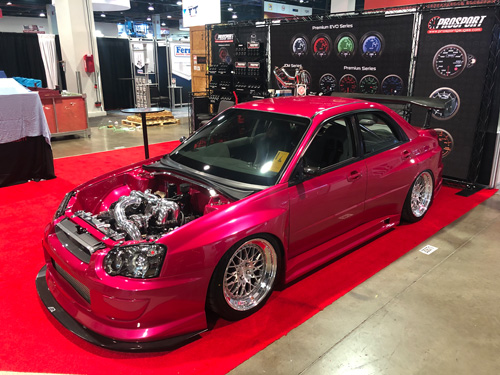 The rest of the exterior conveys an aggressive, muscular look, thanks to a molded-in wide-body kit from APR Performance that integrates the wide-body fenders with the OE front fenders and sheetmetal hood to maintain the OEM metal gaps. In the rear, an APR carbon spoiler enhances aerodynamics and adds a racy styling note.
The rest of the exterior conveys an aggressive, muscular look, thanks to a molded-in wide-body kit from APR Performance that integrates the wide-body fenders with the OE front fenders and sheetmetal hood to maintain the OEM metal gaps. In the rear, an APR carbon spoiler enhances aerodynamics and adds a racy styling note.
“Even though it’s kind of wild with the wide-body kit, it still has the stock STI look to it,” Croll noted.
Under the hood, the engine bay has been completely shaved and coated in matching paint. The headlight buckets were modified to accommodate an IAG Magnum short-block engine with built heads, an IAG clear timing cover and a pink HKS timing belt to match the paint scheme. A Cosworth intake feeds 2,000cc injectors, and a CSF radiator keeps the engine cool. All told, the flex-fuel engine assembly produces close to an estimated 700 hp, which spin a set of Falken tires mounted on CCW rims.
Inside is an Alcantara gray interior featuring the original carpet, Sparco seats with etched-in logos, a Rallytech carbon-fiber rear seat delete, GT-spec chassis, and a one-of-a-kind carved aluminum rollcage. Reverse-hung Wilwood pedals control clutching and braking, and a full complement of Pro Sport gauges monitor engine functions.
_______________________ _______________________

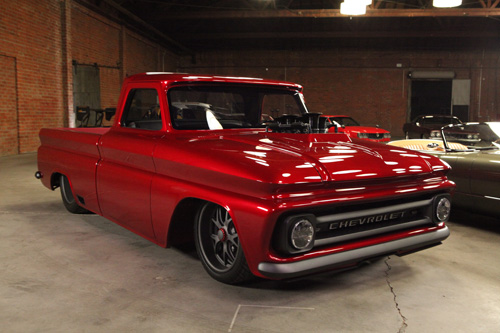 Builder: Mark Giambalvo
Builder: Mark Giambalvo
Creative Rod & Kustom, Womelsdorf, Pennsylvania
Vehicle: ’65 Chevrolet C10
Category: Truck/Off-Road
The 2020 Truck category winner, Mark Giambalvo’s C10 started as a previous owner’s abandoned 20-year-old project rig, which Giambalvo then rehabbed and rebuilt into the finished creation you see today. The goal, he said, was to blend a Pro Street flavor with more modern influences.
Scarcely a body panel hasn’t seen some modification on the truck. The top was chopped 2 in., and an all-new hood was sectioned and equipped with ’55 Chevy hood hinges. The body was narrowed 5 in., and the doors were given the suicide treatment.
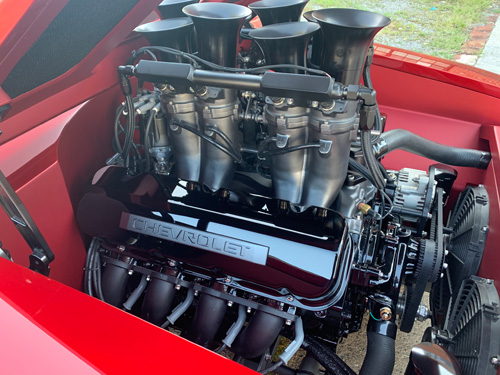 The one-piece front end features custom inner fender panels, and the grille has been recessed 1 in. into the truck. In the rear is a fully molded bed with a molded-shut tailgate. The bumpers were sourced from a ’69 Camaro, and the custom acrylic windshield was fabricated by A&M Hot Rod Glass. The body is covered in PPG 2019 Candy Red Tri-Coat with clear matte accents applied to afford a more modern look.
The one-piece front end features custom inner fender panels, and the grille has been recessed 1 in. into the truck. In the rear is a fully molded bed with a molded-shut tailgate. The bumpers were sourced from a ’69 Camaro, and the custom acrylic windshield was fabricated by A&M Hot Rod Glass. The body is covered in PPG 2019 Candy Red Tri-Coat with clear matte accents applied to afford a more modern look.
The project began with a stock chassis, which was boxed and outfitted with custom crossmembers. An Art Morrison front section was grafted in later, as was a rear section fabricated from 2x4 box tubing.
Between the framerails resides a Dart 572 Chevy big-block topped with a Kinsler injection system that’s been painted matte gray to match the finish on the Cerakoted Schott wheels. Exhaust is handled by custom exit pipes that have been frenched into the bedsides. A TCI six-speed transmission sends power to a 9-in. rearend, which turns a set of Mickey Thompson tires. The truck rides on a ladder-bar suspension and is halted by 14-in. Wilwood brakes.
Inside the Chevy is an all-custom leather interior from Bux Customs and a ’60 Chevy dash that has been treated to a host of Classic Instruments gauges.
_______________________ _______________________
Builder: Cody Medeisis
Modern Carriage Werks, Bridgeview, Illinois
Vehicle: ’68 Chevrolet Camaro
Category: Young Guns

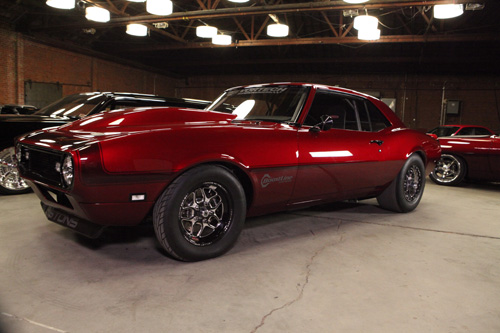 “One of the things I like about this car is that you can drive it anywhere—not only to the racetrack but to any car show—and compete very well with it,” Cody Medeisis said of his ’68 Camaro, which took eight months to build on nothing but nights and weekends. Wherever it goes, it’s a worthy Young Guns category winner for 2020.
“One of the things I like about this car is that you can drive it anywhere—not only to the racetrack but to any car show—and compete very well with it,” Cody Medeisis said of his ’68 Camaro, which took eight months to build on nothing but nights and weekends. Wherever it goes, it’s a worthy Young Guns category winner for 2020.
Starting under the hood, the Camaro is equipped with a 388ci LS engine that’s been outfitted with a Callies crankshaft, BoostLine connecting rods, JE pistons, Frankenstein Monster Series heads, Holley EFI, a Vortech V-7 YSi-B supercharger and a custom stainless-steel exhaust equipped with MagnaFlow mufflers and Granatelli Motorsports exhaust cutouts.
Aeromotive components enhance fuel flow; Cometic gaskets keep the heads properly seated; Derale cooling products help keep temperatures under control; and an Optima battery provides spark. The engine produces an estimated 900 hp. Because it’s intended to compete at Hot Rod Drag Week, it’s built to finish a 1,000-mi. race.
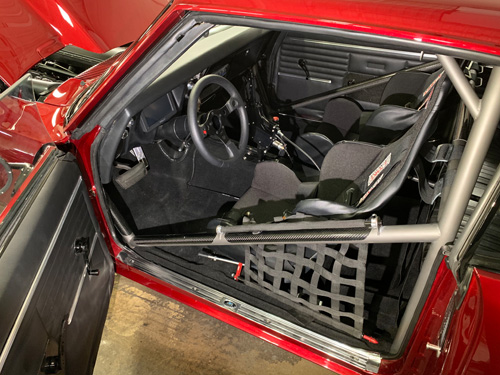
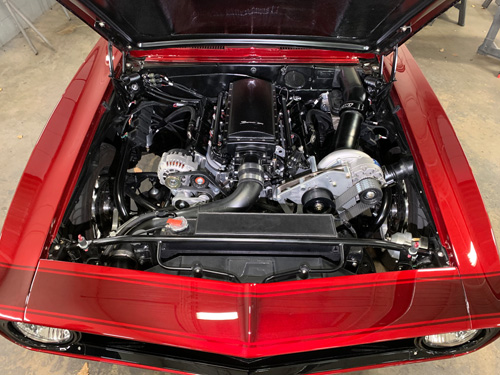 Behind the engine, a FTI Pro Series Powerglide transmission transfers power to a modified 9-in. rearend. Mickey Thompson tires and wheels are braked by Wilwood discs, and the rear ladder-bar suspension was replaced with old-school leaf springs in order to conform to the race-class specifications in which the car often competes.
Behind the engine, a FTI Pro Series Powerglide transmission transfers power to a modified 9-in. rearend. Mickey Thompson tires and wheels are braked by Wilwood discs, and the rear ladder-bar suspension was replaced with old-school leaf springs in order to conform to the race-class specifications in which the car often competes.
The most labor-intensive part of the eight-month frame-up build, Medeisis said, was the paint and bodywork, all of which was designed and applied by the builder. The body was sandblasted down to bare metal, and then a custom paint scheme—a pink base with red candy on top—was meticulously applied along with ’68-inspired striping that was ghosted in red candy.
All of it was then blocked and hand buffed so that it looks like a mirror. Medeisis estimated that he spent at least 400 hours on the paint and body alone.
_______________________ _______________________
Builder: Chip Foose
Foose Design, Huntington Beach, California
Vehicle: ’74 Jaguar E-Type Roadster
Category: Sport Compact

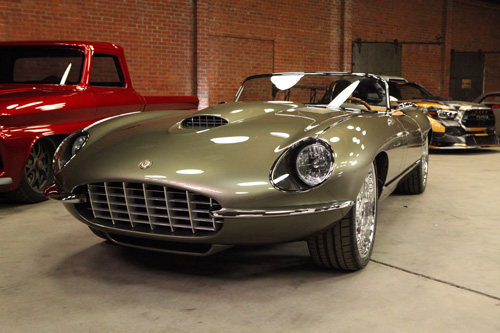 Master builder Chip Foose summed up his BOTB goals: “I have a customer who has spent a lot of money for me to build a nice car for him. If we win Battle of the Builders, then I did my job.”
Master builder Chip Foose summed up his BOTB goals: “I have a customer who has spent a lot of money for me to build a nice car for him. If we win Battle of the Builders, then I did my job.”
The 2020 Sport Compact category winner, this E-type continues the Foose tradition of impeccable build quality while maintaining a keen eye on aesthetics, taking out the heavy-handed details and creating a more tailored car, Foose said.
The vehicle started life as a ’74 E-Type, but only the hood center section, grille surround, front cowl and floor remain of the unmodified stock parts. Up front, the bumper guards were deleted, and hand-formed one-off bumpers were made to a smoother styling line. The grille work is all custom, as are the headlight lenses and moldings. The hood scoop was extended rearward to better complement the rake of the windshield. The hood louvers were reversed to create a smoother styling line, and the front and rear badging is courtesy of a Jaguar 120.
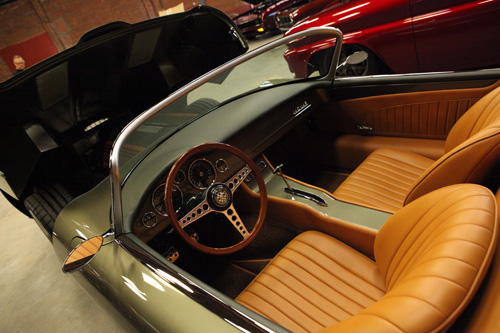
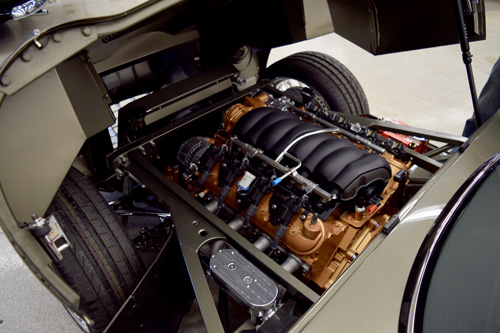 The rear bodywork was equally extensive, with all of the sheetmetal aft of the doors composed of custom components. The rear deck lid was lengthened and narrowed, and the custom rear quarters were blistered out an additional 21/2 in. on each side to accommodate a wider-than-stock wheel and tire combination.
The rear bodywork was equally extensive, with all of the sheetmetal aft of the doors composed of custom components. The rear deck lid was lengthened and narrowed, and the custom rear quarters were blistered out an additional 21/2 in. on each side to accommodate a wider-than-stock wheel and tire combination.
The taillights, moldings, bumpers and trim were all hand fabricated. The rocker panels were extended 2 in. downward for an improved look, and Curtis Speed side mirrors were fitted to hand-made mirror stems. When assembly was complete, the bodywork was treated to custom Glasurit Palm Copper paint.
Under the hood rests an LS3 crate engine that’s backed by a 4L60E transmission. A custom ram-air intake was hand fabricated, as were the radiator and condenser. A one-off MagnaFlow dual system handles the exhaust. The suspension design was kept stock, though it was narrowed 4 in. in front and 6 in. in the rear to clear wider tires and wheels. Custom Foose-designed faux spoke “billet wire” wheels provide a measure of exterior dazzle while retaining a classic look.
_______________________ _______________________
The Winner: SEMA360 Battle of the Builders Champion
Builder: Brady Ranweiler
Show Cars Automotive, New Ulm, Minnesota
Vehicle: ’63 Chevrolet Custom Wagon
Category: Hot Rod

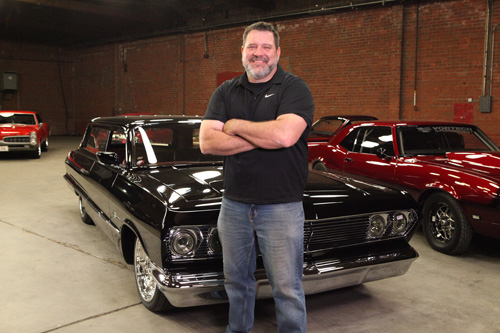 “It’s a huge honor to be a part of this,” Brady Ranweiler said of participating in the BOTB finals, and his fellow builders honored him, along with his co-builders—his father Bradley and brother Cory—with the top prize at this year’s competition. Originally a four-door ’63 Chevy wagon, the custom two-door conversion is the first wagon ever to win the overall title at Battle of the Builders. Photos don’t do this vehicle justice, as the Chevy utilizes more than 300 one-off components.
“It’s a huge honor to be a part of this,” Brady Ranweiler said of participating in the BOTB finals, and his fellow builders honored him, along with his co-builders—his father Bradley and brother Cory—with the top prize at this year’s competition. Originally a four-door ’63 Chevy wagon, the custom two-door conversion is the first wagon ever to win the overall title at Battle of the Builders. Photos don’t do this vehicle justice, as the Chevy utilizes more than 300 one-off components.
Start with the fully unitized front end, where the front outer fenders are melded into the firewall and the lower inner fenders are likewise integrated into the floor. The one-off front bumper is a slide-in unit that uses no brackets or bolts to secure. The roof was lowered roughly 3 in., and the angle of the A-pillars was altered 7 degrees and moved forward. Aft of the A-pillars is a single piece of 17-ft. sheetmetal featuring custom hand-built B- and C-pillars—and, of course, losing the rear passenger doors to create a two-door wagon. The glasswork is likewise all custom, courtesy of A&M Hot Rod Glass.
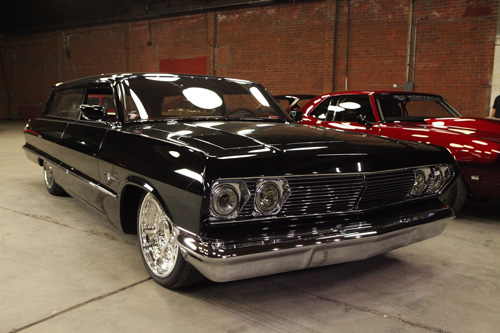 The customizer’s touch can be seen all across the rear of the Chevy as well. The rear windshield molding took 70 hours of bending to fit to the bodywork. The drip moldings were cut out of brass on a precision wood router table and then custom mandrel bent. The rear gate, like the hood, is a power unit, and the far-left taillight is set up to rotate 180 degrees out of position under power to reveal the fuel filler door.
The customizer’s touch can be seen all across the rear of the Chevy as well. The rear windshield molding took 70 hours of bending to fit to the bodywork. The drip moldings were cut out of brass on a precision wood router table and then custom mandrel bent. The rear gate, like the hood, is a power unit, and the far-left taillight is set up to rotate 180 degrees out of position under power to reveal the fuel filler door.
A peek under the hood reveals a clean presentation, with all fasteners and wiring save the plug wires hidden from view. For instance, lines for the one-off cooling fans are embedded inside two of the fins and routed through the fan shroud. All told, more than 100 custom parts are used in the engine bay. The uncluttered look continues throughout the undercarriage, where all noticeable fasteners have been replaced by custom-machined bolts that have been hidden from view.
For all its many refinements, the wagon has plenty of brute power on tap. Resting between the rails of an Art Morrison chassis is an old-school, cast-iron 409 V8 bored .100 over and equipped with a 502 crank and rods. Now displacing 509 ci, the Hillborn-
injected engine produces close to 650 hp. It’s backed by a TCI transmission and kept cool by an all-custom cooling system. Power is transferred to a set of Pirelli tires wrapped around Evod wheels, and 14-in. Wilwood brakes bring the wagon to a stop.
The Chevy’s interior is highlighted by custom tanned Italian oxblood leather from M&M Auto Interiors. As with the exterior, many small touches are seamlessly integrated into the design, including the seat frames with stainless trim that were sourced from a ’59 Cadillac Eldorado.


